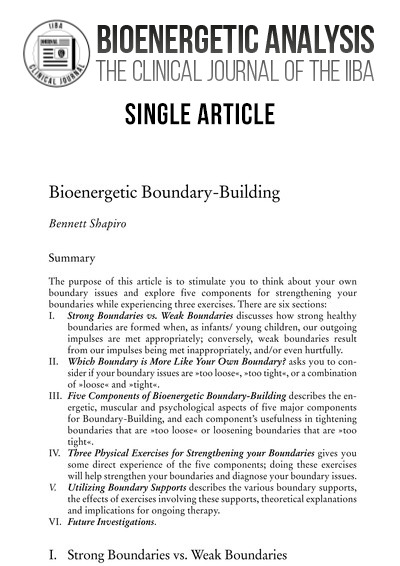Bioenergetic Boundary-Building
DOI:
https://doi.org/10.30820/0743-4804-2006-16-155Аннотация
The purpose of this article is to stimulate you to think about your own boundary issues and explore five components for strengthening your boundaries while experiencing three exercises. There are six sections: I. Strong Boundaries vs. Weak Boundaries discusses how strong healthy boundaries are formed when, as infants/ young children, our outgoing impulses are met appropriately; conversely, weak boundaries result from our impulses being met inappropriately, and/or even hurtfully. II. Which Boundary is More Like Your Own Boundary? asks you to consider if your boundary issues are »too loose«, »too tight«, or a combination of »loose« and »tight«. III. Five Components of Bioenergetic Boundary-Building describes the energetic, muscular and psychological aspects of five major components for Boundary-Building, and each component’s usefulness in tightening boundaries that are »too loose« or loosening boundaries that are »too tight«. IV. Three Physical Exercises for Strengthening your Boundaries gives you some direct experience of the five components; doing these exercises will help strengthen your boundaries and diagnose your boundary issues. V. Utilizing Boundary Supports describes the various boundary supports, the effects of exercises involving these supports, theoretical explanations and implications for ongoing therapy. VI. Future Investigations.
Загрузки
Как цитировать
Выпуск
Раздел
Лицензия

Это произведение доступно по лицензии Creative Commons «Attribution-NonCommercial-NoDerivatives» («Атрибуция — Некоммерческое использование — Без производных произведений») 4.0 Всемирная.
This work is licensed under the Creative Commons Attribution-NonCommercial-NoDerivatives 4.0 International License (CC BY-NC-ND 4.0). This license allows private use and unmodified distribution, but prohibits editing and commercial use (further information can be found at: https://creativecommons.org/licenses/by-nc-nd/4.0/). The terms of the Creative Commons licence only apply to the original material. The reuse of material from other sources (marked with a reference) such as charts, illustrations, photos and text extracts may require further permission for use from the respective copyrights holder.


